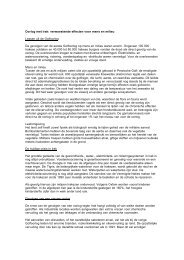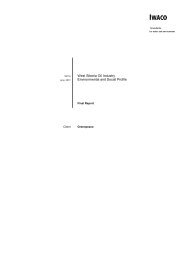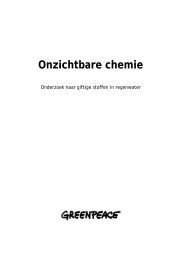man-made chemicals in human blood. levels of - Greenpeace ...
man-made chemicals in human blood. levels of - Greenpeace ...
man-made chemicals in human blood. levels of - Greenpeace ...
Create successful ePaper yourself
Turn your PDF publications into a flip-book with our unique Google optimized e-Paper software.
groups. This approach was chosen to obta<strong>in</strong> <strong>in</strong>formation about a wide range <strong>of</strong> pollutants and about<br />
possible relations between <strong>levels</strong> with<strong>in</strong> the same <strong>in</strong>dividual. Animal studies usually evaluate the effect<br />
<strong>of</strong> one s<strong>in</strong>gle agent. There is <strong>in</strong>creas<strong>in</strong>g evidence that the hu<strong>man</strong> is exposed to a variety <strong>of</strong> <strong>chemicals</strong><br />
which either might augment or oppose the effects seen when encountered s<strong>in</strong>gly. This might especially<br />
be true regard<strong>in</strong>g endocr<strong>in</strong>e disrupt<strong>in</strong>g effects. A downside <strong>of</strong> this approach was the limited number <strong>of</strong><br />
participants that could be <strong>in</strong>cluded <strong>in</strong> the study due to f<strong>in</strong>ancial constra<strong>in</strong>ts. The number at the same time<br />
is <strong>in</strong> our op<strong>in</strong>ion sufficient to provide an impression <strong>of</strong> the <strong>levels</strong> <strong>in</strong> the Netherlands.<br />
For the study volunteers were recruited via a call on the Dutch radio. A selection was <strong>made</strong> from the<br />
respondents based on area <strong>of</strong> liv<strong>in</strong>g, age and gender. We can not exclude some bias <strong>in</strong> the participants<br />
who either might have been concerned about pollution <strong>in</strong> general or have concerns due to their specific<br />
liv<strong>in</strong>g conditions. As we <strong>made</strong> a random selection <strong>of</strong> only seven percent <strong>of</strong> all volunteers we believe the<br />
risk <strong>of</strong> bias is small. As the participants were <strong>in</strong>formed already at the recruitment that they would not be<br />
<strong>in</strong>formed about their own <strong>levels</strong>, we expected not to <strong>in</strong>clude participants who only were <strong>in</strong>terested <strong>in</strong><br />
their own level <strong>of</strong> pollution.<br />
In this study we did not observe any relation between <strong>levels</strong> and demographic data. Age, liv<strong>in</strong>g area, sex<br />
and smok<strong>in</strong>g, at present or <strong>in</strong> the past, were not related to <strong>levels</strong> <strong>of</strong> the different <strong>chemicals</strong>. Occupation<br />
only was found to be related to BDE-153. The amount <strong>of</strong> body fat showed a negative correlation with a<br />
number <strong>of</strong> compounds. At the same time, a rather wide range <strong>of</strong> <strong>levels</strong> was detected for some<br />
compounds. The most likely explanation is differences <strong>in</strong> exposure, although we were not able to relate<br />
these to a s<strong>in</strong>gle factor. Special studies are needed to p<strong>in</strong>po<strong>in</strong>t sources <strong>of</strong> contam<strong>in</strong>ation. Given the range<br />
<strong>in</strong> <strong>levels</strong>, it is unlikely that the variation <strong>in</strong> <strong>levels</strong> is only due to differences <strong>in</strong> metabolism and excretion.<br />
The <strong>levels</strong> <strong>of</strong> brom<strong>in</strong>ated flame retardants found <strong>in</strong> this study are comparable to results <strong>of</strong> other studies<br />
<strong>in</strong> Western Europe but significantly lower compared to <strong>levels</strong> reported from the USA (12,13). The use<br />
<strong>of</strong> some <strong>of</strong> these <strong>chemicals</strong> is considerably higher <strong>in</strong> the USA due <strong>in</strong> part to the specifics <strong>of</strong> regulations<br />
on fire prevention.<br />
The most commonly detected congener <strong>in</strong> this study is BDE-153, though <strong>in</strong> the vast majority <strong>of</strong><br />
volunteers <strong>levels</strong> were not above 10 pg/gram serum. One <strong>in</strong>dividual, a process operator, showed a value<br />
<strong>of</strong> 206 pg/gram with high <strong>levels</strong> also for BDE-28, -47, -99, -100, -159, -183 and -209. We did not detect<br />
the source <strong>of</strong> contam<strong>in</strong>ation <strong>in</strong> this <strong>in</strong>dividual. BDE 209, found <strong>in</strong> 11 <strong>of</strong> the <strong>in</strong>dividuals, showed one<br />
high value <strong>of</strong> 1944 pg/gram. However, none <strong>of</strong> the other congeners were observed <strong>in</strong> this <strong>in</strong>dividual<br />
and no explanation for this s<strong>in</strong>gle value was found. HBCD and TBBPA, two flame retardants which are<br />
<strong>in</strong>creas<strong>in</strong>gly widely used, were found <strong>in</strong> 11 and 32 <strong>of</strong> the 91 samples. The correlation between BDE-47,<br />
-99, -100, -153 and -183 is to be expected s<strong>in</strong>ce these compounds commercially are available as<br />
mixtures (penta- and octa-). BDE- 209, HBCD and TBBPA on the other hand, are commercially<br />
available as more or less pure compounds<br />
The organot<strong>in</strong> compounds were hardly detectable is this population. The low <strong>levels</strong> might be due to the<br />
restricted use <strong>of</strong> these <strong>chemicals</strong> <strong>in</strong> our country and a limited fish consumption.<br />
Musk is orig<strong>in</strong>ally a sexual scent signal. Nowadays <strong>man</strong>y different artificial musk compounds are used<br />
<strong>in</strong> perfumes, detergents, soap, body lotions and deodorizers. The older (nitromusk) compounds MK and<br />
MX, as well as MM and MT were found <strong>in</strong> only very few samples. This is <strong>in</strong> accordance with a study <strong>of</strong><br />
Kafferle<strong>in</strong> et al (14,15) who showed decl<strong>in</strong><strong>in</strong>g <strong>levels</strong> after reduc<strong>in</strong>g the use <strong>of</strong> these <strong>chemicals</strong>.<br />
Remarkably, MA, also an older musk, was still observed <strong>in</strong> over 50% <strong>of</strong> the samples. Whether this is<br />
due to cont<strong>in</strong>ued use or a higher persistence needs further study. The two most abundant musk<br />
compounds were AHTN and HHCB. Look<strong>in</strong>g at the high correlation between <strong>levels</strong> <strong>of</strong> these, it is most<br />
likely that these compounds are commonly used together. It is unknown however if the comb<strong>in</strong>ed<br />
exposure cause more or less health effect <strong>in</strong> the hu<strong>man</strong>. We are not aware <strong>of</strong> any study regard<strong>in</strong>g the<br />
8
















